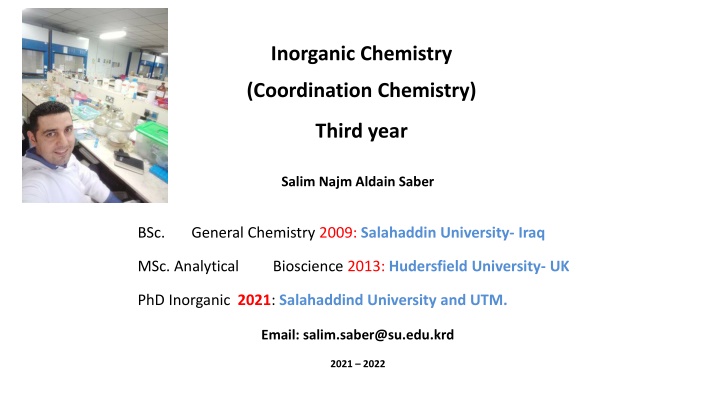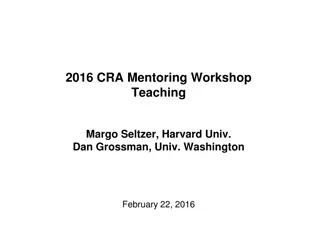
Nomenclature of Coordination Compounds: IUPAC Rules and Examples
Learn about the nomenclature of coordination compounds following IUPAC guidelines, including rules for naming cations, ligands, and more. Explore examples of coordination compound formulas and names. Understand the systematic naming conventions for coordination entities to effectively communicate chemical structures and compositions in inorganic chemistry.
Download Presentation

Please find below an Image/Link to download the presentation.
The content on the website is provided AS IS for your information and personal use only. It may not be sold, licensed, or shared on other websites without obtaining consent from the author. If you encounter any issues during the download, it is possible that the publisher has removed the file from their server.
You are allowed to download the files provided on this website for personal or commercial use, subject to the condition that they are used lawfully. All files are the property of their respective owners.
The content on the website is provided AS IS for your information and personal use only. It may not be sold, licensed, or shared on other websites without obtaining consent from the author.
E N D
Presentation Transcript
Inorganic Chemistry (Coordination Chemistry) Third year Salim Najm Aldain Saber BSc. General Chemistry 2009: Salahaddin University- Iraq MSc. Analytical Bioscience 2013: Hudersfield University- UK PhD Inorganic 2021: Salahaddind University and UTM. Email: salim.saber@su.edu.krd 2021 2022
Nomenclature of Coordination Compounds The formulas and names adopted for coordination entities are based on the recommendations of the International Union of Pure andAppliedChemistry (IUPAC). The IUPAC names are more correct, but trivial names and abbreviations are still commonly used. Nomenclature Nomenclature rules: rules:1 1 1. The positive ion (cation) comes first, followed by the negative ion (anion). K3[Fe(CN)6] [Ag(NH3)2]Cl diamminesilver(I) chloride potassium hexacyanoferrate(III) Tetraamminedichloronickel(II) Hexaamminenickel(II) ion
Nomenclature rules:2 Within the coordination sphere, the ligands are named before the metal, but in formulas the metal ion is written first. K[V(CO)6] [Co(NH3)6]Cl3 hexaarnminecobalt(III) chloride Potassium hexacarbonyl Vanadate (-1) [Cu(NH3)4]SO4 tetraamminecopper(II) sulfate Nomenclature rules:3 The number of ligands of one kind is given by the following prefixes. [Co(NH3)6]Cl3 Hexaammincobalt(III) chloride [Co(NH2CH2CH2NH2)3]Cl3 Tris(ethylenediamine)cobalt(III) chloride [Co(NH2CH2CH2NH2)2Cl2]+ dichlorobis(ethylenediamine)cobalt(III) ion [Fe(C5H4N-C5H4N)3]+2 tris(bipyridine)iron(II) ion
Nomenclature rules:4 Ligands are named in alphabetical order (according to the name of the ligand, not the prefix) or gave anionic ligands first, then neutral ligands. [Co(NH3)4Cl2]Cl tetraamminedichlorocobalt(III) chloride dichlorotetraamminecobalt(III) chloride [CoCl2(NH3)4]Cl [Pt(NH3)BrCl(CH3NH2)] amminebromochloromethylamineplatinum(II), K[CoBrCl(CN)2(NH3)2] K[Co(NH3)2BrCl(CN)2]
Nomenclature rules:5 Anionic ligands are given an o suffix. Neutral ligands retain their usual name. Coordinated water is called aqua and coordinated ammonia is called ammine. [Co(NH3)4Cl2]Cl tetraamminedichlorocobalt(III) chloride [Cr(NH3)3(H2O)3]Cl3 triamminetriaquachromium(III) chloride [CoCl(NO2)(NH3)4]Cl tetraamminechloronitrito-N-cobalt(III) Chloride [CoCl(ONO)(NH3)4]Cl tetraamminechloronitrito-O-cobalt(III)
Nomenclature rules: 1. The positive ion (cation) comes first, followed by the negative ion (anion). 2. Within the coordination sphere, the ligands are named before the metal, but in formulas the metal ion is written first. 3. The number of ligands of one kind is given by the following prefixes. 4. Ligands are named in alphabetical order (according to the name of the ligand, not the prefix) or gave anionic ligands first, then neutral ligands. 5. Anionic ligands are given an o suffix. Neutral ligands retain their usual name. Coordinated water is called aqua and coordinated ammonia is called ammine.
Nomenclature rules:6 Two systems exist for designating charge or oxidation number: 1. The Stock system: The Stock system puts the calculated oxidation number of the metal ion as a Roman numeral in parentheses after the name of the metal. 2. Ewing-Bassett system: The Ewing-Bassett system puts the charge on the coordination sphere in parentheses after the name of the metal. [Pt(NH3)4]+2 The Stock system : tetraammineplatinum(II) Ewing-Bassett : tetraammineplatinum(2+), Nomenclature rules:7 if the charge is negative, the suffix -ate is added to the name of the coordination sphere. [PtCl4]2- tetrachloroplatinate(II) The Stock system : tetraammineplatinum(II) Ewing-Bassett : tetraammineplatinum(2+), [Pt(NH3)4]+2 [Fe(CN)6]3 tetrachloroplatinate(2-) hexacyanoferrate(III)
When the complex is negatively charged, the names for the following metals are derived from the sources of their symbols, rather than from their English names:
Nomenclature rules: 8 The prefixes cis- and trans- designate adjacent and opposite geometric locations. [PtC12(NH3)2] [PtC12(NH3)2] cis- diamminedichloroplatinum(II), trans-diamminedichloroplatinum(II), [CoCl2(NH3)4]+ [CoCl2(NH3)4]+ cis- tetraamminedichlorocobalt(III), trans-tetraamminedichlorocobalt(III), Nomenclature rules: 9 Bridging ligands between two metal ions have the prefix - tris(tetraammine- -dihydroxocobalt)cobalt(6+), [Co(Co(NH3)4(OH)2)3]+6 -amido- -hydroxobis(tetramminecobalt)(4+), [(NH3)4Co(OH)(NH2)Co(NH3)4]+4
Nomenclature rules: 1. 2. 3. 4. The positive ion (cation) comes first, followed by the negative ion (anion). Within the coordination sphere, the ligands are named before the metal, but in formulas the metal ion is written first. The number of ligands of one kind is given by the following prefixes. Ligands are named in alphabetical order (according to the name of the ligand, not the prefix) or gave anionic ligands first, then neutral ligands. Anionic ligands are given an o suffix. Neutral ligands retain their usual name. Coordinated water is called aqua and coordinated ammonia is called ammine. Two systems exist for designating charge or oxidation number: A. The Stock system B. Ewing-Bassett system if the charge is negative, the suffix -ate is added to the name of the coordination sphere. The prefixes cis- and trans- designate adjacent and opposite geometric locations Bridging ligands between two metal ions have the prefix - When the complex is negatively charged, the names for the following metals are derived from the sources of their symbols, 5. 6. 7. 8. 9. 10.
Examples (NH4)2[Ni(C2O4)2(H2O)2] [Ag(NH3)2][Ag(CN)2] [Fe(NH3)6][Cr(CN)6] pentaamminebromocobalt(III) sulfate hexaammineiron(III) hexacyanochromate (III)






















